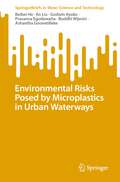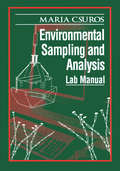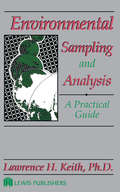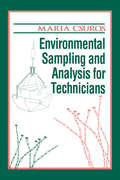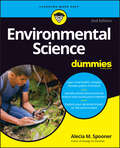- Table View
- List View
Environmental Risk Mitigation: Coaxing a Market in the Battery and Energy Supply and Storage Industry
by Barbara Weiss Michiyo ObiThis book presents an extensive review of the context and an analysis of the market for clean energy technologies, with batteries as the primary case study. The focus of this book is on clean energy technology and in particular, on renewable energy and portable, mobile and stationary battery and energy supply. The authors examine how effectively countries with large and advanced economies are building and coaxing the markets needed to effectively mitigate environmental risk. The analysis takes a country-level perspective of some of the largest and most technologically advanced economies in the world including China, France, Germany, Japan, Korea, the United Kingdom and the United States. The authors explore the measures being taken to foster markets that effectively reduce environmental risk, increase its resilience and even its recovery. In the concluding chapter, the authors suggest that while the market for environmental risk mitigation remains nascent, the possibility for its rapid development is high. A number of market coaxing mechanisms to promote its more rapid development are proposed. The book will be of interest to researchers, policy makers, business strategists, and academics in the fields of political science and business management.
Environmental Risks Posed by Microplastics in Urban Waterways (SpringerBriefs in Water Science and Technology)
by Beibei He An Liu Godwin Ayoko Prasanna Egodawatta Buddhi Wijesiri Ashantha GoonetillekeThis book presents comprehensive knowledge regarding the spatial and temporal distributions, influential factors, interactions with coexisting contaminants, migration behavior, and environmental risk posed by microplastics (MPs) in urban waterways. It provides a novel theoretical approach for the combined risks from MPs and coexisting contaminants, and advanced three-dimensional modeling techniques for different MPs’ dispersal and transport behaviors in urban waterways. Additionally, this book presents a scientifically robust investigation on the correlations between various influential factors and heterogeneity in relation to MP presence in river systems. The new knowledge presented would be of particular interest to readers such as urban water management professionals, urban plastic waste regulators, decision-makers, urban planners, and water environment quality model developers, as it provides practical solutions and recommendations for plastic-polluted river quality improvement from a risk management perspective.
Environmental Role of Wetlands in Headwaters (Nato Science Series: IV: #63)
by Josef Krecek Martin HaighInternationally, the wetlands of headwater and upland regions provide many valuable environmental services. This book moves towards a more comprehensive inventory of the benefits and costs of headwater wetlands. It evaluates the research that tries to understand the tolerances, exchanges, checks and balances within headwater landscapes and the downstream impacts of changes in wetlands. It employs case studies and reviews from 21 nations spanning Europe, Africa, Asia and the Americas. It explores the new policy frameworks, changes in land husbandry, new systems for community education, participatory processes and technological interventions required for the effective management of headwater wetlands and the full integration of wetlands (including newly constructed wetlands) into environmental management and planning. In the past, most research dealt with wetlands as isolated features, this book examines wetlands in their watershed management context.
Environmental Sampling and Analysis: Lab Manual
by Maria CsurosThis manual covers the latest laboratory techniques, state-of-the-art instrumentation, laboratory safety, and quality assurance and quality control requirements. In addition to complete coverage of laboratory techniques, it also provides an introduction to the inorganic nonmetallic constituents in environmental samples, their chemistry, and their control by regulations and standards. Environmental Sampling and Analysis Laboratory Manual is perfect for college and graduate students learning laboratory practices, as well as consultants and regulators who make evaluations and quality control decisions. Anyone performing laboratory procedures in an environmental lab will appreciate this unique and valuable text.
Environmental Sampling and Analysis: Lab Manual
by Maria CsurosThis manual covers the latest laboratory techniques, state-of-the-art instrumentation, laboratory safety, and quality assurance and quality control requirements. In addition to complete coverage of laboratory techniques, it also provides an introduction to the inorganic nonmetallic constituents in environmental samples, their chemistry, and their control by regulations and standards. Environmental Sampling and Analysis Laboratory Manual is perfect for college and graduate students learning laboratory practices, as well as consultants and regulators who make evaluations and quality control decisions. Anyone performing laboratory procedures in an environmental lab will appreciate this unique and valuable text.
Environmental Sampling and Analysis: A Practical Guide
by LawrenceH. KeithThis concise book covers all the critical aspects of environmental sampling and analysis. Extensively peer-reviewed by scientists from the U.S. Environmental Protection Agency and other government agencies, industry and academia, it is packed with practical advice and tips from renowned experts.Planning, sampling, analysis, QA/QC, and reporting are discussed for air, water, solid liquid, and biological samples, with emphasis on the interdependence between sampling and analytical activities. Special requirements for sampling devices, containers, and preservatives are provided with convenient checklists for sampling plans and protocols.New and revised recommendations involving method detection levels, reliable detection levels, and levels of quantitation are discussed in conjunction with laboratory reports and user presentations of data near analytical detection limits.This is a valuable and comprehensive reference book for chemists, technicians, consultants, lawyers, regulators, engineers, quality control officers, news and information managers, teachers, and students.
Environmental Sampling and Analysis: A Practical Guide
by LawrenceH. KeithThis concise book covers all the critical aspects of environmental sampling and analysis. Extensively peer-reviewed by scientists from the U.S. Environmental Protection Agency and other government agencies, industry and academia, it is packed with practical advice and tips from renowned experts.Planning, sampling, analysis, QA/QC, and reporting are discussed for air, water, solid liquid, and biological samples, with emphasis on the interdependence between sampling and analytical activities. Special requirements for sampling devices, containers, and preservatives are provided with convenient checklists for sampling plans and protocols.New and revised recommendations involving method detection levels, reliable detection levels, and levels of quantitation are discussed in conjunction with laboratory reports and user presentations of data near analytical detection limits.This is a valuable and comprehensive reference book for chemists, technicians, consultants, lawyers, regulators, engineers, quality control officers, news and information managers, teachers, and students.
Environmental Sampling and Analysis for Technicians
by Maria CsurosThis book provides the basic knowledge in sample collection, field and laboratory quality assurance/quality control (QA/QC), sample custody, regulations and standards of environmental pollutants. The text covers sample collection, preservation, handling, detailed field activities, and sample custody. It provides an overview of the occurrence, source, and fate of toxic pollutants, as well as their control by regulations and standards. Environmental Sampling and Analysis for Technicians is an excellent introductory text for laboratory training classes, namely those teaching inorganic nonmetals, metals, and trace organic pollutants and their detection in environmental samples.
Environmental Sampling and Analysis for Technicians
by Maria CsurosThis book provides the basic knowledge in sample collection, field and laboratory quality assurance/quality control (QA/QC), sample custody, regulations and standards of environmental pollutants. The text covers sample collection, preservation, handling, detailed field activities, and sample custody. It provides an overview of the occurrence, source, and fate of toxic pollutants, as well as their control by regulations and standards. Environmental Sampling and Analysis for Technicians is an excellent introductory text for laboratory training classes, namely those teaching inorganic nonmetals, metals, and trace organic pollutants and their detection in environmental samples.
Environmental Sampling for Trace Analysis
by Bernd MarkertOften too little attention is given to the sampling before and after actual instrumental measurement. This leads to errors, despite increasingly sensitive analytical systems. This is one of the first books to pay proper attention to representative sampling. It offers an overview of the most common techniques used today for taking environmental samples. The techniques are clearly presented, yield accurate and reproducible results and can be used to sample - air - water - soils and sediments - plants and animals. A comprehensive handbook, this volume provides an excellent starting point for researchers in the rapidly expanding field of environmental analysis.
Environmental Sampling for Unknowns
by Kathleen Hess-KosaEnvironmental Sampling for Unknowns covers modern approaches to indoor and outdoor environmental sampling, with an emphasis on identifying unknown substances.
Environmental Sampling for Unknowns
by Kathleen Hess-KosaEnvironmental Sampling for Unknowns covers modern approaches to indoor and outdoor environmental sampling, with an emphasis on identifying unknown substances.
Environmental Science: Society, Nature, and Technology
by Takashiro AkitsuThis book presents the current aspects of environmental issues in view of chemical processes particularly with respect to two facets: social sciences along with chemistry and natural sciences. The former facet explores the environmental economics and policies along with chemical engineering or green chemistry and the latter the various fields of environmental studies. The book was conceptualized in the form of e-learning content, such as PowerPoint presentation, with explanatory notes to a new style of lectures on environmental science in a university at undergraduate level. Each chapter of the book comprises a summary of the contents of the chapter; a list of specific terms and their explanation; topics that can be taken up for discussion among college students, mainly freshmen in liberal arts, and for enhancing general knowledge; and problems and solutions using active learning methods.
Environmental Science: Society, Nature, and Technology
by Takashiro AkitsuThis book presents the current aspects of environmental issues in view of chemical processes particularly with respect to two facets: social sciences along with chemistry and natural sciences. The former facet explores the environmental economics and policies along with chemical engineering or green chemistry and the latter the various fields of environmental studies. The book was conceptualized in the form of e-learning content, such as PowerPoint presentation, with explanatory notes to a new style of lectures on environmental science in a university at undergraduate level. Each chapter of the book comprises a summary of the contents of the chapter; a list of specific terms and their explanation; topics that can be taken up for discussion among college students, mainly freshmen in liberal arts, and for enhancing general knowledge; and problems and solutions using active learning methods.
Environmental Science: Active Learning Laboratories and Applied Problem Sets
by Travis P. Wagner Robert SanfordOne of the few lab books available in the field, Environmental Science is designed to provide environmental scientists with active learning situations that demonstrate the impacts of interactions between humans and the environment. It encourages readers to reflect on real life conditions and the connection to the environment and sustainability. Emphasis is placed on writing and communication through lab reports, presentations, and real-world scenarios. Environmental scientists will be able to apply concepts in the lab and gain a stronger understanding of the field.
Environmental Science: Active Learning Laboratories and Applied Problem Sets
by Travis P. Wagner Robert M. SanfordHistorically viewed as a sub-discipline of biology or ecology, environmental science has quickly grown into its own interdisciplinary field; grounded in natural sciences with branches in technology and the social science, today’s environmental science seeks to understand the human impacts on the Earth and develop solutions that incorporate economic, ethical, planning, and policy thinking. This lab manual incorporates the field’s broad variety of perspectives and disciplines to provide a comprehensive introduction to the everyday practice of environmental science. Hands-on laboratory activities incorporate practical techniques, analysis, and written communication in order to mimic the real-world workflow of an environmental scientist. This updated edition includes a renewed focus on problem solving, and offers more balanced coverage of the field’s diverse topics of interest including air pollution, urban ecology, solid waste, energy consumption, soil identification, water quality assessment, and more, with a clear emphasis on the scientific method. While labs focus on the individual, readers are encouraged to extrapolate to assess effects on their campus, community, state, country, and the world.
Environmental Science: Active Learning Laboratories and Applied Problem Sets
by Travis P. Wagner Robert M. SanfordHistorically viewed as a sub-discipline of biology or ecology, environmental science has quickly grown into its own interdisciplinary field; grounded in natural sciences with branches in technology and the social science, today’s environmental science seeks to understand the human impacts on the Earth and develop solutions that incorporate economic, ethical, planning, and policy thinking. This lab manual incorporates the field’s broad variety of perspectives and disciplines to provide a comprehensive introduction to the everyday practice of environmental science. Hands-on laboratory activities incorporate practical techniques, analysis, and written communication in order to mimic the real-world workflow of an environmental scientist. This updated edition includes a renewed focus on problem solving, and offers more balanced coverage of the field’s diverse topics of interest including air pollution, urban ecology, solid waste, energy consumption, soil identification, water quality assessment, and more, with a clear emphasis on the scientific method. While labs focus on the individual, readers are encouraged to extrapolate to assess effects on their campus, community, state, country, and the world.
Environmental Science and Information Application Technology: Proceedings of the 2014 5th International Conference on Environmental Science and Information Application Technology (ESIAT 2014), Hong Kong, November 7-8, 2014
by David ChanEnvironmental Science and Information Application Technology contains selected papers from the 2014 5th International Conference on Environmental Science and Information Application Technology (ESIAT 2014, Hong Kong, 7-8 November 2014). The book covers a wide variety of topics: - Global Environmental Change and Ecosystems Management - Graphic and I
Environmental Science and Information Application Technology: Proceedings of the 2014 5th International Conference on Environmental Science and Information Application Technology (ESIAT 2014), Hong Kong, November 7-8, 2014
by David ChanEnvironmental Science and Information Application Technology contains selected papers from the 2014 5th International Conference on Environmental Science and Information Application Technology (ESIAT 2014, Hong Kong, 7-8 November 2014). The book covers a wide variety of topics: - Global Environmental Change and Ecosystems Management - Graphic and I
Environmental Science and International Politics: Acid Rain in Europe, 1979-1989, and Climate Change in Copenhagen, 2009
by David E. Henderson Susan K. HendersonEnvironmental Science and International Politics features two reacting games in one volume, immersing students in the complex process of negotiating international treaties to control environmental pollution. The issues are similar in all the modules; environmental justice, national sovereignty, and the inherent uncertainty of the costs and benefits of pollution control. Students also must understand the basic science of each problem and possible solutions. Acid Rain in Europe, 19779-1989 covers the negotiation of the Long Range Transport Pollution treaty. This was the first ever international pollution control treaty and remains at the forefront of addressing European pollution. This game can be used in a variety of ways and to examine either sulfur dioxide pollution, nitrogen oxide pollution, or both. This game includes summaries of a number of relevant technical articles to support student arguments. Students must deal with the limitations of national resources as they decide how much of their limited money to spend.Climate Change in Copenhagen, 2009 covers the negotiations at the Conference of Parties 15 meeting that was attended by a large number of national leaders. The game also includes representatives of non-government organizations and the press. Students wrestle with the need to work within conflicting limits set by their governments.
Environmental Science and Technology: A Sustainable Approach to Green Science and Technology, Second Edition
by Stanley E. ManahanFormally established by the EPA nearly 15 years ago, the concept of green chemistry is beginning to come of age. Although several books cover green chemistry and chemical engineering, none of them transfer green principles to science and technology in general and their impact on the future. Defining industrial ecology, Environmental Science and Tec
Environmental Science and Technology: International Conference on Environmental Science and Technology (Environmental Science and Engineering)
by Zeng YangThis book features a collection of high-quality and peer-reviewed papers from 2022 13th International Conference on Environmental Science and Technology, which was held in Shandong, China, during October 21–23, 2022. ICEST is held annually as a platform for presentation of new advances and research results in the fields of Environmental Science and Technology. This year, we focus on the theme: Environmental Protection and Sustainable Development. With the continuous development of human society, environmental problems are becoming more and more serious. How to realize the rational use of resources, realize the sustainable development of ecological environment, and protect the environment on which human beings live has become an urgent problem to be solved. Based on the conference theme this year, the presentations include the topical areas of environmental sustainability, environmental restoration, waste minimization, solid waste management, water pollution control, water treatment and reclamation, air pollution control, carbon capture and storage and environmental monitoring, etc.
Environmental Science For Dummies
by Alecia M. SpoonerThe easy way to score high in Environmental Science Environmental science is a fascinating subject, but some students have a hard time grasping the interrelationships of the natural world and the role that humans play within the environment. Presented in a straightforward format, Environmental Science For Dummies gives you plain-English, easy-to-understand explanations of the concepts and material you'll encounter in your introductory-level course. Here, you get discussions of the earth's natural resources and the problems that arise when resources like air, water, and soil are contaminated by manmade pollutants. Sustainability is also examined, including the latest advancements in recycling and energy production technology. Environmental Science For Dummies is the most accessible book on the market for anyone who needs to get a handle on the topic, whether you're looking to supplement classroom learning or simply interested in learning more about our environment and the problems we face. Presents straightforward information on complex concepts Tracks to a typical introductory level Environmental Science course Serves as an excellent supplement to classroom learning If you're enrolled in an introductory Environmental Science course or studying for the AP Environmental Science exam, this hands-on, friendly guide has you covered.
Environmental Science For Dummies
by Alecia M. SpoonerThe easy way to score high in Environmental Science Environmental science is a fascinating subject, but some students have a hard time grasping the interrelationships of the natural world and the role that humans play within the environment. Presented in a straightforward format, Environmental Science For Dummies gives you plain-English, easy-to-understand explanations of the concepts and material you'll encounter in your introductory-level course. Here, you get discussions of the earth's natural resources and the problems that arise when resources like air, water, and soil are contaminated by manmade pollutants. Sustainability is also examined, including the latest advancements in recycling and energy production technology. Environmental Science For Dummies is the most accessible book on the market for anyone who needs to get a handle on the topic, whether you're looking to supplement classroom learning or simply interested in learning more about our environment and the problems we face. Presents straightforward information on complex concepts Tracks to a typical introductory level Environmental Science course Serves as an excellent supplement to classroom learning If you're enrolled in an introductory Environmental Science course or studying for the AP Environmental Science exam, this hands-on, friendly guide has you covered.
Environmental Science For Dummies
by Alecia M. SpoonerAce your environmental science class and get smart about the environment Environmental Science For Dummies is a straightforward guide to the interrelationships of the natural world and the role that humans play in the environment. This book tracks to a typical introductory environmental science curriculum at the college level—and is great as a supplement or study guide for AP Environmental Science, too. Uncover fascinating facts about the earth’s natural resources and the problems that arise when resources like air, water, and soil are contaminated by pollutants. If you’re in need of extra help for a class, considering a career in environmental science, or simply care about our planet and want to learn more about helping the environment, this friendly Dummies resource is a great place to start. The key concepts of environmental science, clearly explained All about the changing climate, including new understanding of methane release in the arctic Earth’s natural resources and the importance of protecting them A new chapter on environmental justice, where issues of poverty and sustainability intersectA solid foundation in environmental science is essential for anyone looking for a career in the field—and is important knowledge for all of us as we work together to build a sustainable future.

